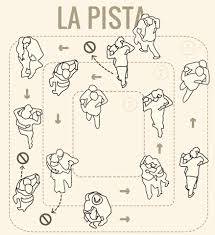
Very nice and simple graphic illustrating some of the key elements of good floorcraft for dancing Argentine Tango. There are more complex illustrations out there and feel free to post them below, but I do like the simplicity of this one.
La Pista translates loosely to "the dance floor." Another commonly used term is La Ronda (The Round) which is more closely related to "the line of dance." In other words, we dance in the line of dance (La Ronda) on the dance floor (La Pista). But these terms can be used interchangeably.
For newer (and not so new) dancers, the main things to notice in this illustration are:
- There is an outer lane, an inner lane, and the center of the dance floor. Generally, better dancers dance in the outer lane, but may sometimes use the inner lane as well, but rarely the center of the floor. It should be noted, that not all dance floors are large enough for these 3 areas. For example, at our milongas (Plaka and 57th), there is really only room enough for an outer lane and a center of the dance floor.
- The outer lane should be wider than what is represented in the illustration. My opinion is that it should be approximately two body widths. You do need room to move a little sideways to execute ochos and basic turns. So, the inner lane or those dancing in the center, should not crowd the outer lane. Too often, dancers straddle the outer and inner lanes.
- Dancers should stay in their lane during an entire song. If you are forced from the outer lane into the middle lane, you should stay there until the song ends and only then move back to the outer lane. It is considered very bad manners to constantly switch lanes during a song.
- Dancers should generally enter the dance floor at the corner's, unless it is an oddly shaped dance floor. Leader's entering the floor should attempt to make eye contact with the leader that they are entering the floor in front of. That leader should then nod or indicate approval for the couple to enter the floor in front of them. You do not have to do this if there is plenty of room for you to enter the dance floor without getting in anyone's way, but this is rarely the case on a crowded dance floor. This also means that leader's need to have their heads up when dancing and paying attention, especially when near a corner, so that they can acknowledge couples wanting to enter La Ronda. (Organizers: Do not put tables in the corner, that is where people need to cue up to enter the dance floor.)
- Avoid going backwards against the line of dance. A small back step is generally acceptable, but it should be small and preferably after you have first moved forward. What is unacceptable is taking large or multiple back steps against the line of dance. It is especially unacceptable for leaders to be facing against the line of dance and moving forward. I often say that the leader behind me should never be able to focus on my face. The only time he sees my face should be as it is in motion turning. It should never stop and move towards him.
- This is not in the illustration, but is one that I see more and more. Do not walk across the dance floor if people have already started dancing. Organizers can help with this by making sure that there is space behind the tables for walking, if at all possible.
Click here for more about Floorcraft and General Milonga Etiquette.

